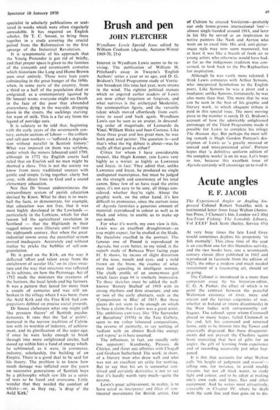Brush and pen
JOHN FLETCHER
Wyndham Lewis Special Issue edited by William Cookson (Agenda, Autumn-Winter 1969-70, 21s) Interest in Wyndham Lewis seems to be re- viving. The publication of William H. Pritchard's essay in Twayne's 'English Authors' series a year or so ago, and D. G. Bridson's Third Programme study of Vortic- ism broadcast this time last year, were straws in the wind. The rightist political stances which so angered earlier readers of Lewis are now either forgotten or forgiven, and what survives is the archetypal Modernist, the cosmopolitan figure, and the versatile talent which moved effortlessly from escri- toire to easel and back again. Wyndham Lewis can be seen as an avatar, in descend- ing order of magnitude, of Leonardo da Vinci, William Blake and Jean Cocteau. Like these three great and less great men, he was both poet and painter. The question is—and that's what the big debate is about—was he really all that good as either?
Critics for whom I have considerable respect, like Hugh Kenner, rate Lewis very highly as a writer; as highly as Lawrence and Joyce, in fact. They admit that, unlike Lawrence and Joyce, he produced no single undisputed masterpiece, but must be judged on the strength and consistency of his total canon. Since few of us have read the entire opus, it's not easy to be sure, all things con- sidered, whether they're right. About the graphic work, on the other hand, it's less difficult to pronounce, since the current issue of Agenda furnishes a generous amount of material, reproduced in colour as well as in black and white, to enable us to make up our minds.
For what it's worth, my own view is this. Lewis was an excellent draughtsman—as you might expect, for he studied at the Slade. He therefore excelled in the portrait. The famous one of Pound is reproduced in Agenda, but even better, to my mind, is the superb study of Rebecca West facing page 81. It shows, by means of slight distortion of the nose, mouth and eyes, and a mild frown on the brow, the essence of what men find appealing in intelligent women. The chalk profile of an anonymous girl which faces page 68 is similarly impressive. To these sketches must be added the well- known 'Battery Shelled' of 1919 with its strong rhythms and firm structure, and one or two of the early abstracts, such as the 'Composition in Blue' of 1915. But these pieces do not seem to be enough on which to base a claim that Lewis was a great artist. The ambitious canvases, like 'The Surrender of Barcelona' (1936) in the Tate Gallery, seem to me rather laboured compositions, the reverse of painterly, to say nothing of 'radiant with an almost Bach-like energy and repose' as is here asserted.
The influences, in fact, are usually only too apparent: Kandinsky, Picasso, de Chirico, and (later on) affinities with Chagall and Graham Sutherland. The work, in short, of a literary man who drew well and who was not an excellent art critic for nothing. But to say that his art is somewhat con- trived and certainly derivative is not to say that it's hardly worth very much—quite the reverse.
Lewis's great achievement, in reality, is to have acted as interpreter and filter of con- tinental movements for British artists. Out of Cubism he created Vorticisrn—probably our only home-grown international 'ism'— almost single-handed around 1914, and later in his life he served as an inspiration to native painters like Nash and Ayrton who went on to excel him. His arid, anti-pictur- esque style may now seem mannered, but at least it was like a breath of fresh air to • young artists who otherwise would have had, as far as the indigenous tradition was con- cerned, to look back to the Pre-Raphaelites for inspiration.
Although he was vastly more talented, I think Lewis compares with Arthur Symons, who interpreted Symbolism to the English poets. Like Symons he was a pivot and a mediator; unlike Symons, fortunately, he was also more than that. The more that he was can be seen in the best of his graphic and literary work, to which eloquent tribute is paid in this special issue. The most moving piece in the number is surely D. G. Bridson's account of how the admirably enlightened patronage of the Third Programme made it possible for Lewis to complete his trilogy The Human Age. But perhaps the most tell- ing remark is Hugh Gordon Porteus's des- cription of Lewis as 'a greatly misread or unread and misrepresented artist'. Porteus hopes that 'a definitive uniform edition of the complete works' is on its way. Let's hope so too, because this excellent issue of Agenda certainly will encourage us to read it.


































 Previous page
Previous page